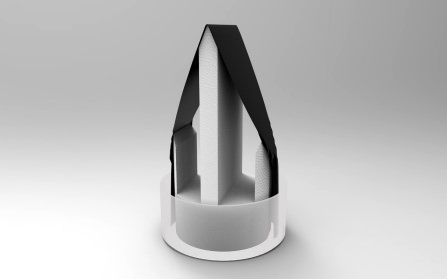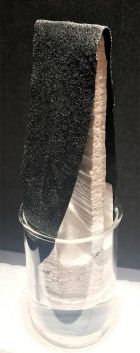Engineers Upgrade Ancient, Sun-powered Tech to Purify Water with Near-perfect Efficiency
Published on by Water Network Research, Official research team of The Water Network in Technology
Low-cost device — shaped like a birdhouse — could help provide drinking water to people affected by natural disasters.
 The idea of using energy from the sun to evaporate and purify water is ancient. The Greek philosopher Aristotle reportedly described such a process more than 2,000 years ago.
The idea of using energy from the sun to evaporate and purify water is ancient. The Greek philosopher Aristotle reportedly described such a process more than 2,000 years ago.
Now, researchers are bringing this technology into the modern age, using it to sanitize water at what they report to be record-breaking rates.
By draping black, carbon-dipped paper in a triangular shape and using it to both absorb and vaporize water, they have developed a method for using sunlight to generate clean water with near-perfect efficiency.

Image: The new water purification technique involves draping a sheet of carbon-dipped paper in an upside-down “V.” The paper’s bottom edges soak up water, while the carbon coating absorbs solar energy and transforms it into heat for evaporation.
Credit: Huaxiu Chen
“Our technique is able to produce drinking water at a faster pace than is theoretically calculated under natural sunlight,” says lead researcher Qiaoqiang Gan, PhD, associate professor of electrical engineering in the University at Buffalo School of Engineering and Applied Sciences.
As Gan explains, “Usually, when solar energy is used to evaporate water, some of the energy is wasted as heat is lost to the surrounding environment. This makes the process less than 100 percent efficient. Our system has a way of drawing heat in from the surrounding environment, allowing us to achieve near-perfect efficiency.”
The low-cost technology could provide drinking water in regions where resources are scarce, or where natural disasters have struck. The advancements are described in a study published on May 3 in the journal Advanced Science.
Solar stills have been around for a long time. These devices use the sun’s heat to evaporate water, leaving salt, bacteria and dirt behind. Then, the water vapor cools and returns to a liquid state, at which point it’s collected in a clean container.
The technique has many advantages. It’s simple, and the power source — the sun — is available just about everywhere. But unfortunately, even the latest solar still models are somewhat inefficient at vaporizing water.
Gan’s team addressed this challenge through a neat, counterintuitive trick: They increased the efficiency of their evaporation system by cooling it down.
A central component of their technology is a sheet of carbon-dipped paper that is folded into an upside-down “V” shape, like the roof of a birdhouse. The bottom edges of the paper hang in a pool of water, soaking up the fluid like a napkin. At the same time, the carbon coating absorbs solar energy and transforms it into heat for evaporation.
As Gan explains, the paper’s sloped geometry keeps it cool by weakening the intensity of the sunlight illuminating it. (A flat surface would be hit directly by the sun’s rays.) Because most of the carbon-coated paper stays under room temperature, it can draw in heat from the surrounding area, compensating for the regular loss of solar energy that occurs during the vaporization process.
Using this set-up, researchers evaporated the equivalent of 2.2 liters of water per hour for every square meter of area illuminated by the regular sun, higher than the theoretical upper limit of 1.68 liters, according to the new study. The team conducted its tests in the lab, using a solar simulator to generate light at the intensity of one regular sun.
“Most groups working on solar evaporation technologies are trying to develop advanced materials, such as metallic plasmonic and carbon-based nanomaterials,” Gan says. “We focused on using extremely low-cost materials and were still able to realize record-breaking performance.

Image: A central component of the new technology is a sheet of carbon-dipped paper folded into an upside-down “V.” The paper’s sloped geometry keeps it cool by weakening the intensity of light illuminating it. (A flat surface would be hit directly by the sun.) This novel, slanted architecture helped to speed vapor and water generation in experiments.
Credit: Youhai Liu
“Importantly, this is the only example I know of where the thermal efficiency of the solar evaporation process is 100 percent when you consider solar energy input. By developing a technique where the vapor is below ambient temperature, we create new research possibilities for exploring alternatives to high-temperature steam generation.”
Source: University at Buffalo
Media
Taxonomy
- Treatment
- Treatment Methods
- Purification
- Solar Energy
- Water Purification